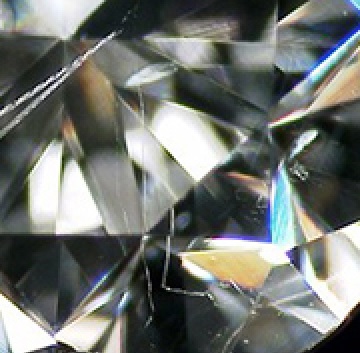A needle inclusion is a type of internal characteristic found in natural diamonds. It appears as a long, thin, needle-like crystal trapped inside the diamond during its formation. These inclusions are often transparent or white, but they can also appear in shades of black, brown, or other colors, depending on the type of mineral present.
How Needle Inclusions Form
Natural diamonds form over billions of years deep within the Earth’s mantle under extreme pressure and heat. During this process, various mineral deposits, gases, or even other diamond crystals can become trapped inside the growing diamond. When these inclusions form in an elongated shape, they are classified as needle inclusions.
Composition: Needle inclusions can be made of other minerals (such as garnet, olivine, or pyroxene) or even diamond itself.
Growth Influence: The presence of a needle inclusion can sometimes indicate the diamond’s growth pattern and conditions within the Earth.
Appearance of Needle Inclusions
Shape: Thin, elongated, needle-like structure
Color: Usually transparent or white, but can also be black, brown, or yellow depending on the trapped material
Size: Ranges from microscopic (only visible under magnification) to larger inclusions that may affect transparency
Position: Found anywhere in the diamond, including near the surface, within the pavilion, or in the crown
Impact of Needle Inclusions on Diamond Quality
1. Clarity Grade
Needle inclusions affect a diamond’s clarity grade, which is assessed by laboratories like DCLA, GIA, and AGS.
If the needle is small and not visible to the naked eye, it may have minimal impact on the clarity grade.
If the needle is large, numerous, or positioned in a way that affects transparency, it may lower the diamond’s clarity rating significantly.
2. Visibility in Jewelry
Small needles in the pavilion (bottom of the diamond): Often not noticeable and have little impact on beauty.
Larger needles near the table (top flat facet): May be more visible and slightly reduce brilliance.
Clusters of needle inclusions: When multiple needles form in the same area, they can create a hazy or cloudy effect, reducing the diamond’s overall brightness.
3. Structural Integrity
Unlike surface-reaching inclusions (such as feathers or cavities), needle inclusions do not typically weaken a diamond’s durability.
However, if located near the girdle or in a region of high stress, a large needle inclusion might slightly affect the diamond’s strength.
How to Identify Needle Inclusions
1. Under Magnification
Needles are difficult to spot with the naked eye but can be seen under a 10x jeweler’s loupe or a microscope. They often appear as thin, hair-like lines inside the diamond.
2. Diamond Grading Reports
Professional reports from DCLA, GIA, or AGS will note needle inclusions under clarity characteristics.
Needles are often indicated on a diamond’s plot diagram, showing their location and size.
3. Using Fluorescence & Light Scattering
Some needles become more visible under UV light.
Strong lighting may make them appear as tiny bright or dark streaks inside the diamond.
Needle Inclusions vs. Other Inclusions
Inclusion Type Description Impact on Clarity
Needle Thin, elongated crystal trapped inside the diamond Minimal unless large or clustered
Pinpoint Tiny, dot-like crystal Very minor effect
Cloud Group of tiny pinpoints, creating a hazy look Can lower brilliance if dense
Feather Small crack or fracture May impact durability
Crystal Distinct mineral inclusion, often shaped like a small crystal Can be noticeable if dark
Are Needle Inclusions a Dealbreaker?
Not necessarily.
If small and not visible to the naked eye, needle inclusions have little impact on beauty or value.
If multiple needles cluster together, they might create a cloudy effect, reducing transparency and brilliance.
Always review a diamond’s clarity in person or with a magnification tool to determine if the needle inclusion affects its overall appearance.
